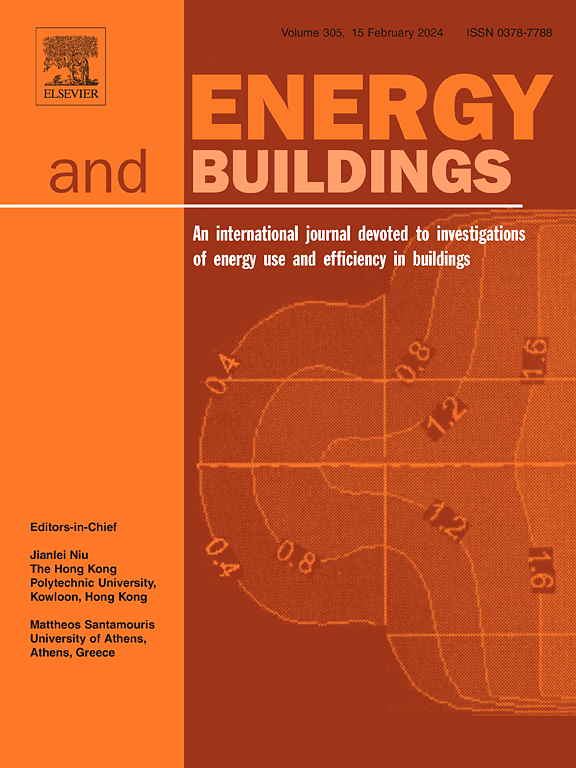Energy-saving potential of cool roofs at the urban scale: A case study of Xiamen city
IF 6.6
2区 工程技术
Q1 CONSTRUCTION & BUILDING TECHNOLOGY
引用次数: 0
Abstract
Urban-scale energy modeling of cool roof retrofits requires detailed knowledge of rooftop. This study developed a high-resolution Urban Building Energy Modeling (UBEM) framework that integrates roof reflectance data for Xiamen City, China. First, building types were classified using Geographic Information System (GIS) and machine learning techniques. Then, historical satellite imagery was analyzed to estimate the building year of each building. Roof color and reflectance were subsequently evaluated using Sentinel-2 and high-resolution imagery. This process resulted in the creation of a multi-source geospatial dataset comprising 37,132 buildings in Xiamen. A physics-based UBEM was then constructed using AutoBPS for 31,608 buildings to simulate energy performance under three scenarios: baseline, measured reflectance, and cool roof retrofit. Compared to the default reflectance value of 20 %, actual roof reflectance in Xiamen reduced energy consumption by 1.8 % (0.94 GWh). Furthermore, three types of cool roof technologies, spray coatings, membranes, and metal roofs, achieved annual energy savings of 4.42 % (2.32 GWh), 3.58% (1.88 GWh), and 2.27 % (1.19 GWh), respectively. Their corresponding peak-load reductions were 10.7 %, 8.97 %, and 5.5 %. Among the 31,608 buildings modelled, 3790 buildings (approximately 12 %) met the economic feasibility criterion of a payback period under 10 years. Of these, 1298 buildings were more suitable for membrane application and 2492 for spray coating. Over their life cycle, these buildings would require an initial investment of 35.3 million CNY and maintenance costs of 39.3 million CNY, yielding electricity savings of 151.67 GWh, equivalent to 89.6 million CNY, and resulting in net savings of 15.0 million CNY.
城市尺度冷屋顶的节能潜力——以厦门市为例
凉爽屋顶改造的城市尺度能源建模需要详细的屋顶知识。本研究开发了一个高分辨率的城市建筑能源建模(UBEM)框架,该框架集成了中国厦门市的屋顶反射率数据。首先,利用地理信息系统(GIS)和机器学习技术对建筑类型进行分类。然后,对历史卫星图像进行分析,估算出每座建筑的建造年份。随后使用Sentinel-2和高分辨率图像评估屋顶颜色和反射率。这一过程产生了包含厦门37132栋建筑的多源地理空间数据集。然后,使用AutoBPS构建了一个基于物理的UBEM,用于模拟31,608栋建筑在三种情况下的能源性能:基线、测量反射率和冷却屋顶改造。与20%的默认反射率值相比,厦门的实际屋顶反射率降低了1.8% (0.94 GWh)的能耗。此外,三种冷屋顶技术,喷涂、膜和金属屋顶,分别实现了每年4.42% (2.32 GWh)、3.58% (1.88 GWh)和2.27% (1.19 GWh)的节能效果。相应的峰值负荷降低分别为10.7%、8.97%和5.5%。在31,608栋建筑模型中,3790栋建筑(约12%)符合投资回收期低于10年的经济可行性标准。其中,1298栋建筑更适合涂膜,2492栋建筑更适合喷涂。在整个生命周期内,这些建筑的初始投资为3530万元,维护费用为3930万元,节电151.67 GWh,折合人民币8960万元,净节电1500万元。
本文章由计算机程序翻译,如有差异,请以英文原文为准。
求助全文
约1分钟内获得全文
求助全文
来源期刊

Energy and Buildings
工程技术-工程:土木
CiteScore
12.70
自引率
11.90%
发文量
863
审稿时长
38 days
期刊介绍:
An international journal devoted to investigations of energy use and efficiency in buildings
Energy and Buildings is an international journal publishing articles with explicit links to energy use in buildings. The aim is to present new research results, and new proven practice aimed at reducing the energy needs of a building and improving indoor environment quality.
 求助内容:
求助内容: 应助结果提醒方式:
应助结果提醒方式:


